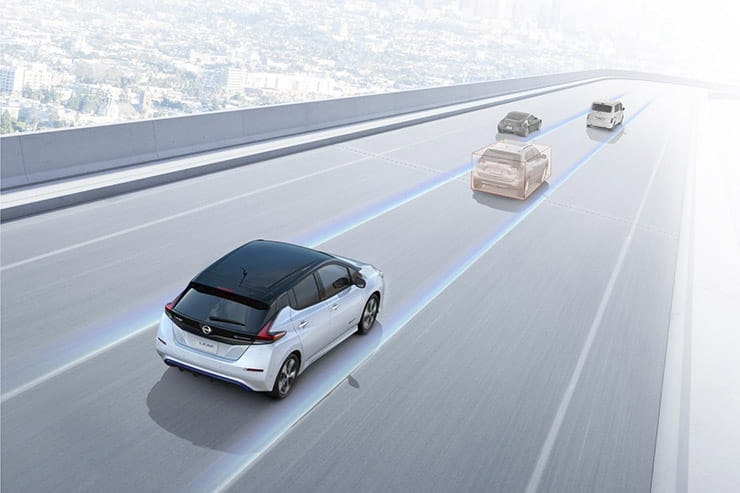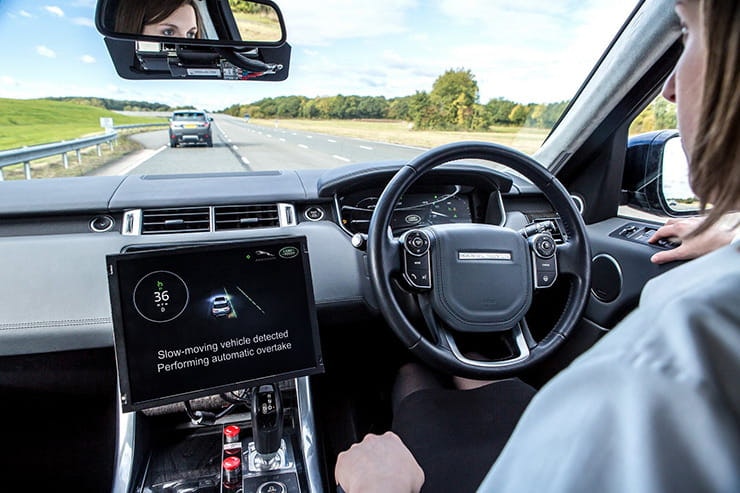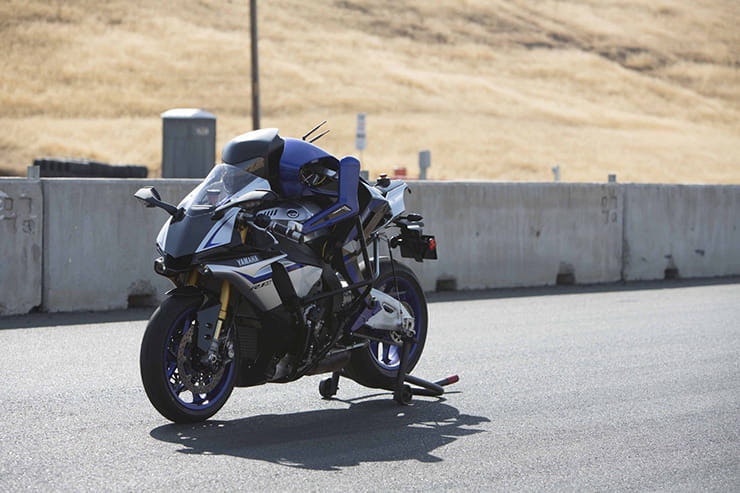How will self-driving vehicles change the roads for the rest of us?
By Ben Purvis
Motorcycle Journalist
03.11.2017
The dream of the self-driving car has been a sci-fi staple for decades but unlike personal jetpacks or laser guns it’s one that’s actually fast becoming a reality. You can walk into a showroom right now and buy a car that will, to all intents and purposes, drive itself.
But what about the rest of us, sharing the roads with these computer-controlled wonders? Are we facing a robotic revolution that will see human-controlled vehicles marginalised, even banned? Will the computers crash, swiftly followed by the vehicles they’re operating? And how do bikes – perhaps the ultimate expression of personal freedom – fit in to all this?
Honda Riding Assist E:
Honda's new self balancing motorcycle concept
What defines an ‘autonomous vehicle’?
While the idea of self-driving cars has been around for ages, the actual introduction of such things has been a creeping – some might say insidious – process. Bit by bit, the elements of technology needed to let the idea work have been introduced, starting on luxury vehicles and quickly filtering down to the mainstream.
Cruise control, able to hold a vehicle at a constant speed, has been around for decades. More recently we’ve seen the introduction of adaptive cruise control, using sensors to judge the distance to the car in front and modulating speed to match it. From there, the onset of automatic braking was natural, even vital, and it’s quickly progressed to the point where some very mundane modern cars can cope with start-stop traffic or motorway use without the driver needing to touch the throttle or brake pedal.
Lane assist is another technology that’s quickly progressed towards autonomy. Early versions simply used cameras to monitor the white lines on the road, and beeped or vibrated if drivers drifted towards them without indicating. Again it was a logical step to move towards self-steering systems that would initially simply ‘assist’ drivers, nudging them away from the lane separators.
With those systems in place – adaptive cruise control, automatic braking and lane assist – it was only a small step to advance towards a car that, at least in some situations, can drive itself.
Levels of autonomy
We all know that our airliner’s autopilot takes care of most things as we jet off for two weeks in Tenerife, but you’d probably sit less comfortably with your in-flight magazine and duty free tipple if there weren’t a couple of human pilots on the flight deck.
And it’s the same with autonomous cars. While there are vehicles that can take care of some of the driving, or even most of it on certain trips, we’re still a little way from ones that can be left to their own devices altogether.
The Society of Automotive Engineers (SAE) has come up with a six-level system to define the progress towards autonomous cars:
Level 0: This is a manually-operated car, but one that has warning systems that alert the human operator to what’s going on around him. Think blind-spot monitoring, things like that.
Level 1: This is where many modern production cars sit now. It covers adaptive cruise control, lane-assist systems and parking assistance. Basically the car takes on a few admin chores, but the driver is really in control at all times.
Level 2: This is defined as ‘hands off’ and means that the car does its own acceleration, braking and steering. Plenty of modern high-end cars can actually do this, but they still require a driver to supervise at all times and be ready to take control. In fact they usually have sensors that monitor the driver to make sure he’s alert and has his hands on the wheel.
Level 3: This is where the absolute state of the art currently lies in terms of production cars. It’s an ‘eyes off’ system, in that – theoretically at least – the driver could turn his attention to something else while the car drives. Audi claims that its 2017 A8 is the world’s first Level 3 autonomous production car, but the self-driving mode can only be used in very specific circumstances; there must be a central barrier and it only works below 37mph. The system’s name – Traffic Jam Pilot – emphasises its low-speed intentions.
Level 4: Dubbed ‘mind off’, level 4 is the natural progression and would let the car take full control in a wider range of situations. With no emergencies, a level 4 autonomous car would take you for a complete trip with no human intervention. You could even sleep in the driver’s seat. But it would still have manual controls for the unexpected situations that the autonomy couldn’t cope with.
Level 5: These vehicles are still some distance away; level 5 autonomy means that cars wouldn’t need manual controls at all. They’d simply be pods that take passengers to their chosen destinations.
So, what is this witchcraft?
Just as you don’t rely purely on your eyes for information when driving or riding, autonomous vehicles use a wide array of sensors. Radar, lidar (a sort of laser-based range-finding system) and loads of stereoscopic cameras are some of the key components, but autonomous cars also use GPS and inertial measurement units to feed information to their computers. In future, vehicle-to-vehicle communication – where cars will talk to one another and even street furniture like traffic lights could be ‘talking’ to passing vehicles – is being worked on, allowing each car’s on-board brain to have a virtual 3d map of precisely what’s going on all around it.
The tech is there, but as usual with these things, the infrastructure and the inconveniences of reality are stumbling blocks. A lack of a legal framework for autonomous cars is one thing – are they allowed to be used? Who’s responsible if one crashes? These questions, and dozens more, still need to be answered.
The semi-autonomous systems that are creeping into use now are an extension of driving safety aides, and as such should be encouraged. After all, anti-lock brakes are, arguably, a form of semi-autonomous driving – you’re letting a computer, more capable than yourself, take over fine control of the brakes. But when full autonomy is considered, whereby the computer is actually making life-or-death decisions on its own, there’s a legislative minefield to be negotiated before such vehicles will be allowed to mingle with the general public.
Nissan ProPilot
Nissan's autonomous car concept
What does it mean for the rest of us?
In the short to medium term, the autonomous vehicles we see on the roads will be glorified cruise control systems. They might take charge on motorways or in traffic jams, but most day-to-day driving for the majority of vehicles will be done by a real human.
From a motorcyclist’s point of view, there are both positives and negatives. Taking the glass-half-full approach, as more and more cars get these semi-autonomous systems, we’ll increasingly see large numbers of drivers – those who really have no interest in driving, and merely do it to get from A to B – starting to use their cars’ autonomy wherever possible. And one good thing about computer-controlled vehicles is that they’ll be predictable. They’ll follow the rules. That means we should see fewer incidents of BMW drives carving across three motorway lanes with nary an indicator in sight. Dawdling grannies and swerving boy-racers will gradually become fewer and further between. Instead there’s a vision of computer-operated choreography creating smooth flows of traffic.
If, as predicted, semi-autonomous and autonomous vehicles reduce accident rates, then further in the future we should see increased speed limits on some roads. And once we get full autonomy, then futurists believe car ownership itself will fall rapidly, with people instead grabbing lifts from mechanised Uber-style taxis, which will operate 24/7, reducing the need for parking spaces and cutting down on overall traffic levels. That might seem a long way off, but Ford reckons it will have fully-autonomous ride-sharing vehicles on the road by 2021, and be selling similar things to the public by 2025.
Tesla Autopilot
Tesla's self driving car is now a reality
And the downsides?
It all sounds utopic, but of course there are potential downsides. We’ve already seen the first crashes involving semi-autonomous cars, most notably a fatal accident in 2016 when Joshua Brown, driving (or should that be ‘riding in’?) a Tesla in autopilot mode hit a truck that was turning in front of him. Investigators, and Tesla, pointed the finger at Brown for not paying attention. To be fair, the Tesla autopilot system, while pioneering and among the most advanced on the market, specifically calls on driver to be constantly alert and ready to take control.
More concerning for those of us on two wheels, Teslas have also been accused of hitting motorcycles. One incident was in Norway, where a Tesla, said to be using autopilot, rear-ended a motorcycle on a motorway in 2016. Another involved a bike cop in Arizona.
The concern, and it’s a valid one, is that the detection systems in autonomous cars are tuned most carefully to pick out other cars on the road. A smaller vehicle, like a motorcycle, is harder for the systems to spot.
One piece of research, “Preliminary Study of the Response of Forward Collision Warning Systems to Motorcycles” by John F Lenkeit and Terrance Smith PhD of Dynamic Research, Inc was presented at the 2016 Intermot show in Cologne. It used a variety of tests on driver assistance systems in eight different cars and showed that while 96% effective in spotting cars, they were only passed tests against bikes on 59% of occasions.
With the current semi-autonomous systems the final responsibility still lies with the driver; they need to remain vigilant for just such circumstances. But human nature is such that, once a driver has become confident in his semi-autonomous car’s abilities, it’s almost inevitable that he’ll take more chances with it.
Autonomous motorcycles
The biggest effect of this new technology on motorcyclists will be the need to share the roads with an increasing number of semi-autonomous – and eventually fully-autonomous – vehicles. But there’s also the question of autonomous bikes to be considered.
On the face of it, the idea of a self-riding motorcycle seems slightly ridiculous. Sure, Honda’s Riding Assist Concept can trundle along at walking pace, and Yamaha’s newly-revealed MOTOROiD concept appears to be part-bike, part pet, but are there serious applications for such self-balancing machines?
Actually, there probably are. On one side, giving a bike the ability to ride autonomously would allow the same sort of relaxed cruise control that the tech offers on cars. There isn’t much indication that riders are begging for that, though. While the vast majority of car users only drive because they have to, motorcyclists are naturally enthusiasts and as such aren’t likely to see riding as a chore.
No, the greater potential for self-riding bikes is as a safety measure – allowing systems where the bike can take control when the rider has lost it. We’ve recently seen an explosion in traction control technology, and this could be the next step towards an uncrashable bike.
The idea of a completely self-riding bike isn’t entirely ridiculous, either. Motorcycles are already well proven as the best way to slice through city traffic, so it’s not hard to imagine robotic couriers delivering small packages in a not-so-distant future. Similarly, we can imagine Amazon, or even Dominos, showing an interest in small, traffic-dodging robot courier bikes. Or what about the police? Yamaha’s MOTOBOT might not be quick enough to beat Rossi around a track (yet) but it would be a great way of tailing criminals without the cost of a helicopter.
Should we fear the autonomous vehicles of the future? No. If we’ve learnt anything in the last century or so of motorised transport it’s that with every generation the vehicles we use – whether cars or bikes – get faster, safer and more reliable. Those of us that don’t want to give up control to computers aren’t likely to be forced to do so, but those with no interest or aptitude for driving will be gradually phased out. Their replacements might be computers, but they’ll have eyes in the backs of their heads, 20-20 night vision and lightning reactions. Who would you rather share the roads with?
Yamaha MOTORoid
Yamaha's self balancing motorcycle that can recognise the rider react to commands
Share on social media:


